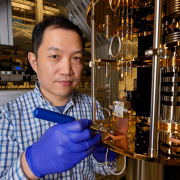Imagine predicting the exact finishing order of the Kentucky Derby from a still photograph taken 10 seconds into the race.
That challenge pales in comparison to what researchers face when trying to study how embryos develop, cells differentiate, cancers form, and the immune system reacts—all using the snapshots from microscopes or genome sequencing.
But in a paper published April 26 in Proceedings of the National Academy of Sciences, researchers from the UChicago Pritzker School of Molecular Engineering and the Chemistry Department unveiled a powerful new method of using the static snapshots from single-cell RNA-sequencing to study how cells and genes change over time.
To develop the method, which they call TopicVelo, the team took an interdisciplinary approach, incorporating concepts from classical machine learning as well as computational biology and chemistry.
“In terms of unsupervised machine learning, we use a very simple, well-established idea. And in terms of the transcriptional model we use, it's also a very simple, old idea. But when you put them together, they do something more powerful than you might expect,” said PME Assistant Professor of Molecular Engineering and Medicine Samantha Riesenfeld, who wrote the paper with Chemistry Department Prof. Suriyanarayanan Vaikuntanathan and their joint student, UChicago Chemistry PhD candidate Cheng Frank Gao.
The trouble with pseudotime
When trying to understand complex processes in the body, researchers often use single-cell RNA-sequencing, or scRNA-seq, to get measurements that are powerful and detailed, but by nature are static.
The trouble is, Riesenfeld explained, “Single-cell RNA-sequencing is destructive. When you measure the cell this way, you destroy the cell.”
This leaves researchers only a snapshot of the moment the cell was measured/destroyed. However, the information many researchers need is how the cells transition over time. They need to know how a cell becomes cancerous, or how a particular gene program behaves during an immune response.
To help figure out dynamic processes from a static snapshot, researchers have traditionally used what’s called “pseudotime.” When an image is captured, it also captures other cells and genes of the same type that might be a little further on in the same process. If the scientists connect the dots correctly, they can gain powerful insights into how the process looks over time.
However, connecting those dots is difficult guesswork, based on the assumption that similar-looking cells are just at different points along the same path—and biology is often much more complicated, with false starts, stops, bursts, and multiple chemical forces tugging on each gene.
Instead of traditional pseudotime approaches, scientists have been interested in an alternate approach known as “RNA velocity,” which looks at the dynamics of transcription, splicing and degradation of the mRNA within those cells. It’s promising, but still early technology.
To improve the RNA velocity approach, TopicVelo embraces—and gleans insights from—a far more difficult stochastic model that reflects biology’s inescapable randomness.
“Cells, when you think about them, are intrinsically random,” said Gao, the first author on the paper. “You can have twins or genetically identical cells that will grow up to be very different. TopicVelo introduces the use of a stochastic model. We're able to better capture the underlying biophysics in the transcription processes that are important for mRNA transcription.”
Machine learning shows the way
The team also realized that another assumption limits standard RNA velocity. “Most methods assume that all cells are basically expressing the same big gene program, but you can imagine that cells have to do different kinds of processes simultaneously, to varying degrees,” Riesenfeld said. Disentangling these processes is a challenge.
Probabilistic topic modeling—a machine learning tool traditionally used to identify themes from written documents—provided the UChicago team with a strategy.
TopicVelo groups scRNA-seq data not by the types of cell or gene, but by the processes those cells and genes are involved in. The processes are inferred from the data, rather than imposed by external knowledge.
“If you look at a science magazine, it will be organized along topics like ‘physics,’ ‘chemistry’ and ‘astrophysics,’ these kinds of things,” Gao said. “We applied this organizing principle to single-cell RNA-sequencing data. So now, we can organize our data by topics, like ‘ribosomal synthesis,’ ‘differentiation,’ ‘immune response,’ and ‘cell cycle’. And we can fit stochastic transcriptional models specific to each process.”
After TopicVelo disentangles this kludge of processes and organizes them by topic, it applies topic weights back onto the cells, to account for what percentage of each cell’s transcriptional profile is involved in which activity.
According to Riesenfeld, “This approach helps us look at the dynamics of different processes and understand their importance in different cells. And that's especially useful when there are branch points, or when a cell is pulled in different directions.”
The results of combining the stochastic model with the topic model are striking. For example, TopicVelo was able to reconstruct trajectories that previously required special experimental techniques to recover. These improvements greatly broaden potential applications.
Gao compared the paper’s findings to the paper itself—the product of many areas of study and expertise.
“At PME, if you have a chemistry project, chances are there’s a physics or engineering student working on it,” he said. “It’s never just chemistry.”
Citation: “Dissection and Integration of Bursty Transcriptional Dynamics for Complex Systems,” Gao et al., Proceedings of the National Academy of Sciences, April 26, 2024. DOI: 10.1073/pnas.2306901121
Funding: NIH.
—Adapted from an article published by the Pritzker School of Molecular Engineering.

